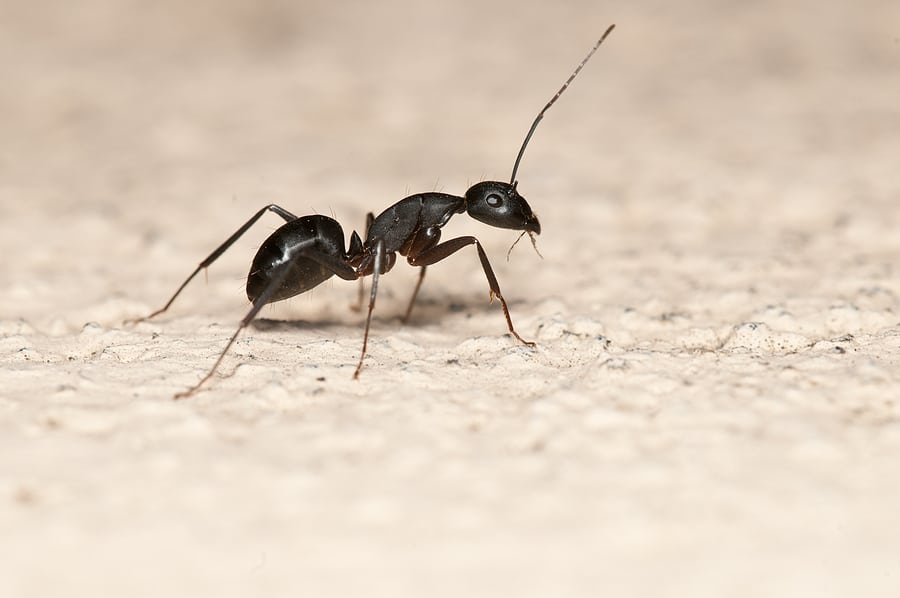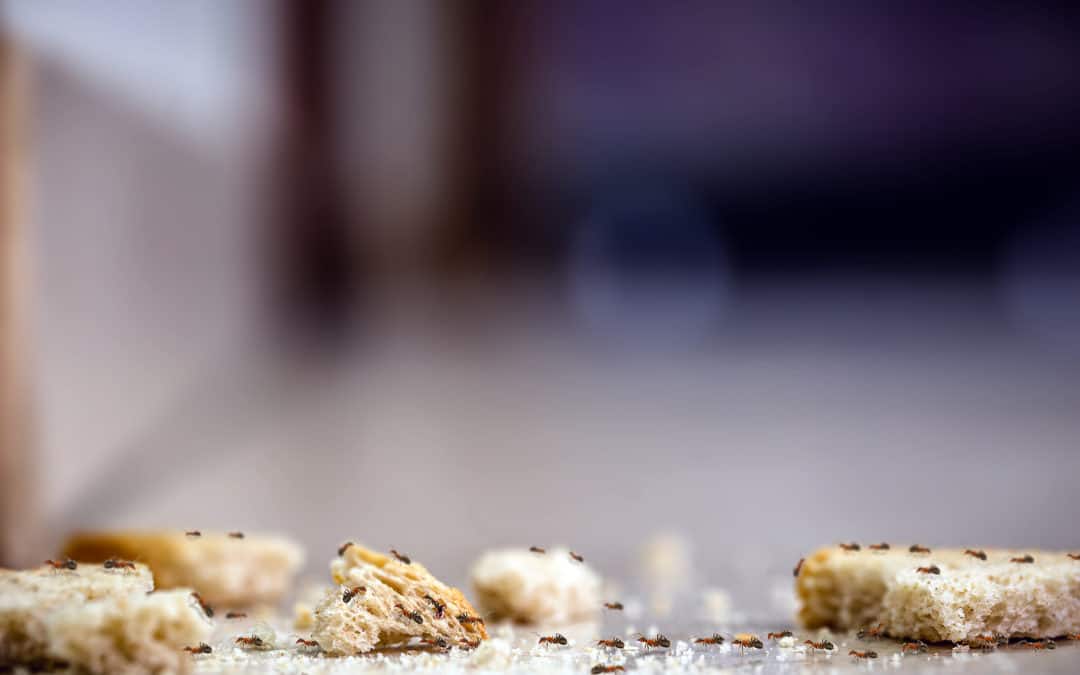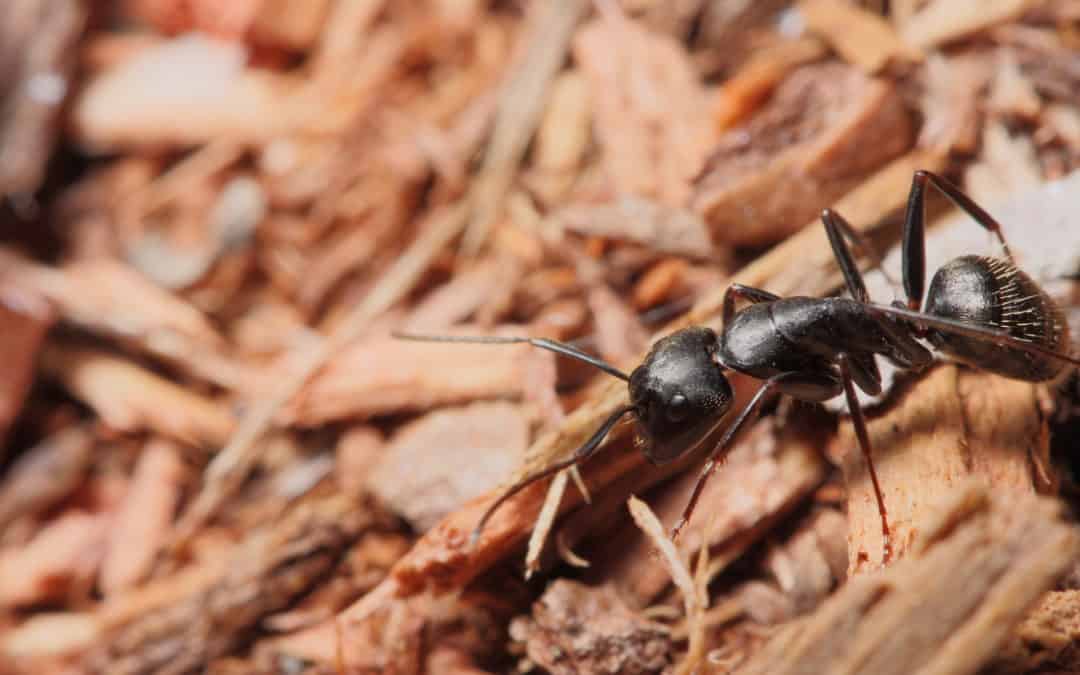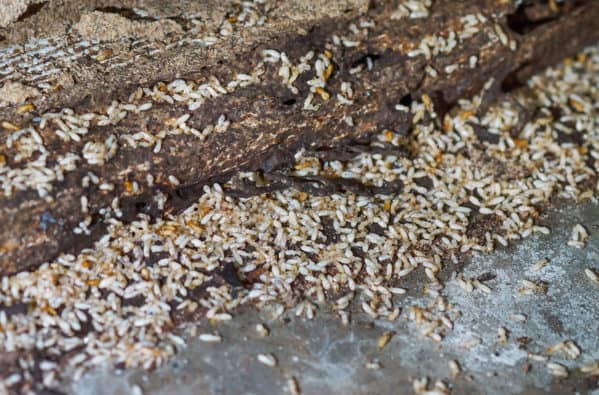READY TO GET STARTED?
REQUEST A FREE ESTIMATE
Fill out the form below or call (888) 466-7849 for a free, no-obligation estimate.

Ant season peaks in the spring and summertime, with these pests oftentimes finding their way inside your home. But did you know that carpenter ants remain active throughout the year? In return, they can cause damage to your home and infest.
Carpenter ants will nest in damaged wood, usually softwood damaged from water. Carpenter ant damage includes excavating wood to expand their nests, often making holes throughout exposed wood. If these ants are found inside, it is also an indication that there is a water issue, such as a leak.
While these ants are most active in the spring and summer, they are also known to infest homes during the winter months, as well. They will forage for food and water, looking for proteins, fats, and sugars. Once inside, these ants will look for a moist environment to help them survive. They can often be found in bathrooms, kitchens, pipes, and roof vents.
While carpenter ants do not die off in the winter months, they will instead become dormant when the temperatures drop. This usually depends on where they have built their nests and how much the temperature has dropped. If they have already found themselves inside, they will remain active or revive from their dormant state once the heat from the house has risen.
To prevent ants from entering your home this fall and winter, consider placing these preventative measures throughout your house,

Ants are considered one of the most pesky nuisance pests homeowners must deal with. Ants will often enter homes during the winter, seeking water and food for survival. Now, with the weather warming, is the perfect time to start putting preventative measures in the most common places ants are found – the kitchen and the bathroom!
The kitchen is an ideal place for ants to infest. These pests are constantly searching for a water source, and the kitchen is the perfect place to find it. If the kitchen isn’t cleaned frequently and thoroughly, ants will invade quickly. Use these ant prevention tips to keep ants out of your kitchen:
The bathroom is highly vulnerable to an ant infestation as all the excess moisture will attract them. Carpenter ants will build their nests in damp areas, such as behind bathroom tiles or under sinks. To prevent ants from infesting your bathroom, take these preventative measures:
If you’ve noticed an influx of ants inside your home, consider calling your local pest control company. Trained service professionals will set you up with a prevention and treatment plan to help prevent these pests during peak ant season.

Every homeowner dreads discovering an ant infestation, whether inside or outside the home. Ants can be a major nuisance as they contaminate food, build their nests in unwanted places, and destroy property. One type of ant in particular, the carpenter ant, is considered a “silent destroyer,” often causing severe damage to homes undetected by excavating wood. These pests can be tough to eliminate but it is possible.
Carpenter ants are ½” to 5/8” long, and are usually red, black, brown, or a combination of these in color. These ants build their nests by creating smooth tunnels inside wood, preferring wet, damp wood. Common places carpenter ants will build their nests include tree stumps, fence posts, window and doorframes, firewood, and other various places with exposed wood. Carpenter ant nests can be problematic to your home as the tunnels they create can damage the structural soundness of wood throughout your property. If you notice sawdust or wood fragments falling throughout your property, there is a good chance that carpenter ants have infested.
Carpenter ants need a constant water source to survive. The first step in preventing ants like these is to eliminate moisture or standing water throughout your property. Consider using a dehumidifier in crawlspaces, basements, and attics to help with dampness. Trim your tree branches and shrubs away from your home, as ants can use these as an access point. Take it a step farther by looking around your property for any gaps or holes and sealing these up with caulk, as ants only need the smallest gap to get inside a house.
Preventing ants might seem like a daunting task; when ants infest it can seem like they are everywhere! Consider reaching out to your local pest control company where they can provide you with a prevention and treatment plan during peak ant season.

It’s the end of the year and as you put together your list of New Year’s resolutions, some simple home repairs might need to make the cut. What you may not realize is that pests could have been quietly chipping away at your home’s value throughout the year. Here are some things to look for and steps to take to preserve the integrity of your home.
Making these adjustments can help you enjoy your home without the pests and the critters. Reach out to your local pest control company to schedule an inspection and to work out a preventative treatment plan to help keep your home safe.

Termites cause billions of dollars in damage each year. Because they work from the inside out, infestations are often not found until significant damage has already been done. Spring marks the beginning of the termite swarming season and these destructive pests are found in most of the United States (except for Alaska). What do you need to know before swarming season starts to help control termites? Find out the answers to many of your termite questions below.
Termites swarm as the weather begins to warm, usually at the beginning of spring or summer and usually after a rain event. Termites swarm when they go in search of a location to establish a new colony. Colonies typically don’t produce a swarm until they have been established for at least 3 years.
If a swarm happens inside your home, most of them will not survive to establish a new colony but it does mean that your home is likely infested. If a swarm happens outside your home or if you notice just a few stragglers inside, your home is most likely not infested but a colony (or multiple colonies) are present nearby.
Swarming termites have one purpose – to reproduce and establish a new colony. In fact, they don’t have biting or chewing mouthparts to cause damage to your home. Several hundred swarmers are produced by each colony but only a small percentage of these actually survive to start the new colony.
Termites have straight antennae and wide bodies without pinched waists. They are usually black or dark brown in color. Swarming termites have wings that are the same length and clear in color. Termites are found in decaying stumps, trees, wood debris, lumber, and other wooden structures. They cause structural damage by eating wood and other cellulose-based products like paper.
Flying ants (also known as carpenter ants) have elbowed antennae and pinched waists. They can be black, brown or reddish in color. They have 2 pairs of wings that differ in size and are tinted brown in color. Carpenter ants also inhabit wood and wood structures; however, they don’t eat wood and therefore do not usually cause any structural damage. They do eat nectar, seeds, other insects, and food debris in and around your home.
Both termites and flying ants swarm as part of their mating process.
The main attractant to termites is food. Termites love to eat anything wood or cellulose-based including lumber, firewood, newspaper, and more. They also like warm, dark places that are undisturbed such as your crawlspace. They also thrive in moist soil, especially around your foundations.
While there are some do-it-yourself options you can do around your home, these are more suitable for termite prevention rather than termite control. Getting rid of termites is a job best left to the professionals. Some things you can do around your home to help prevent termites include:
There are two major types of termite treatment: liquids and baits.
Liquid termite treatments have been around for years. Their purpose is to provide a long-lasting barrier in the soil that keeps termites from entering and infesting buildings. This treatment also helps eliminate termites that are already inside structures as it prevents them from getting back to the soil for supplemental moisture.
Bait termite treatments use a cellulose-based food product combined with a slow acting pesticide. The bait stations are installed below the ground where termites eat the bait and share it with other termites in their colony. This leads to a gradual decline in the termite population infesting the structure.
If you suspect you have a termite problem, contact a professional termite control specialist. A thorough termite inspection by a trained pest control professional is critical in identifying and eliminating a termite infestation from your home.
Lawn Care: How to Keep Your Grass Green in the Summer
5 Ways To Prevent Bed Bugs When Traveling